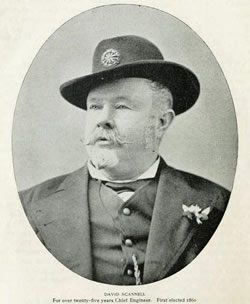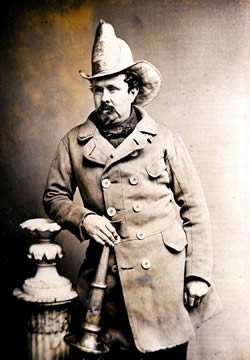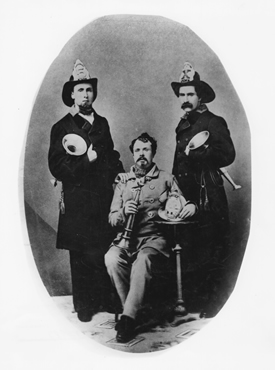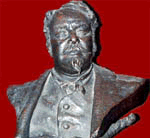
- Guardians Home
- SFFD Home
- Site Map
- Historical Review
- Apparatus
- Chiefs of Department
- Chronology
- Charles H. Ackerson
- Charles J. Brennan
- Keith P. Calden
- Andrew C. Casper
- Emmet C. Condon
- Robert L. Demmons
- John H. Dougherty
- Charles P. Duane
- Joanne M. Hayes-White
- George H. Hossefross
- Francis P. Kelly
- Frederick D. Kohler
- Joseph A. Medina
- Thomas R. Murphy
- William F. Murray
- Jeanine Nicholson
- Edward J. Phipps
- David Scannell
- Patrick H. Shaughnessy
- Albert J. Sullivan
- Dennis T. Sullivan
- Paul J. Tabacco
- Mario H. Trevino
- Edward P. Walsh
- Franklin E. R. Whitney
- Companies
- Events
- Past Events
- SFFD 150th Anniversary
- PPIE 100th Anniversary
- 1906 Expo
- 1989 Quake Party - 2009
- 65' Ladder Presentations
- Broderick & Terry Duel
- Coit Tower 75th Anniversary
- Cole Valley Fair
- Gold Hydrant - April 18th
- Jimmy's Car Show
- Lower Haight Street Fair
- Lotta's Fountain - April 18th
- Musters
- Presidio Car Show
- Station 28 75th Anniversary
- Fireboats
- Firehorses
- Firehouses
- Fires
- In The Line Of Duty
- Museum Collections
- Musters
- Notable People
- Organizations
- Gift Shop
- Volunteers
- Related Links
- Contact Us
- Research Requests
- Photo Gallery
- Videos
- Donations
| Chief Engineers - Chiefs of Department: David S. ScannellChief Engineer
1860 - 1866, 1871 - 1873, 1873 - 1893
David Scannell was born in New York, and he was a very well educated man. He served as an officer in the Mexican War with extraordinary distinction, and in 1851 he came to San Francisco on the steamer "Gold Hunter." He ran unsuccessfully for the office of Sheriff in 1852. A year later he served as Undersheriff to Sheriff William Gorham. In the spring of 1855, he was successful in his bid and was elected to the position of Sheriff. He served during turbulent times in a young and wild San Francisco. In the fall of 1856, he was removed from office because when his bank failed he could not post the bond required to be Sheriff. Upon leaving the Sheriff's department, he turned his attention to the fire department, and became a member of Empire Engine Company No. 1. In the annual election of the Chief Engineer by the members of the department held in December of 1860, Scannell was elected to Chief Engineer, and he quickly won the admiration of his men. He was re-elected each of the next six years. In 1865 the City realized that it would be beneficial to change the department from the volunteer companies to a paid-call organization. In April of 1866, Chief Scannell signed the declaration of approval to make this change over occur the following December. In October of 1866, Chief Scannell lost his bid to be appointed by the Town Council to be the first Chief Engineer of the paid department. Instead they choose Franklin E. R. Whitney as Chief Engineer. Five years later on April 3, 1871, the Town Council did appoint David Scannell as Chief Engineer, and approximately five hundred former volunteers paraded through the streets to show their support for this decision and appreciation for their former Chief. Due to ill health it was necessary for him leave office at the end of April. Amidst much controversy, on March 16, 1874, he was reappointed Chief Engineer. He quickly over came the controversies and remained in office as Chief for the next twenty years, until his death, due to ill health, on March 30, 1893. At the time of his death the department was composed of 25 engine companies, 6 truck companies, 9 hose companies and the first water tower and first fireboat. He was also responsible for the fire codes requiring fire escapes and standpipes on all multi story buildings. His will provided $2,000 to establish a fund for the meritorious service medal which bears his name. The David S. Scannell Medal is awarded to San Francisco firefighters who have performed meritoriously at personal risk of their own life. His legacy in the department remains. In 1909 one of the two new fireboats was commissioned the David S. Scannell in his honor. The David Scannell Club was organized in 1913 by department members in order to maintain and protect the Civil Service provisions of the Charter relating to the Fire Department and to promote the efficiency and good name of the Fire Department. In essence, this was the department's first labor union. It is without question that he was the most influential and esteemed leader in early department history. DAVID SCANNELL A greater contrast than the life and death of Chief David Scannell presents, it would be difficult to imagine. A man of unusual force of character and physical energy, a man who for over half a century had responded to the call of the fire bell in this city or elsewhere, he sat quietly reading his paper on Thursday morning, March 30th, in the engine-house on Bush Street, which he so dearly loved, then the paper slipped from his grasp, and as it fluttered to the floor the spirit of the old man rose and David Scannell was dead. His faithful attendant, Zip Shoen, thought the old man was merely taking a nap, and so in truth he was; but it was a nap from which the fire bell would never awake him. Full of years and honor, respected and loved by those under him, the rugged old man had breathed his last. In the romance of the early days of San Francisco the name of David Scannell will always stand out in bold relief. In the stirring chapters of this city's history he played a most important part. “The Chief," as every one called him, was born in New York City, on January 31, 1820. When quite a young man his adventurous spirit led him to join the New York Volunteer Department, an organization which largely attracted the hardy young men of the city, particularly the class bred to trades and manual labor. It was a notable training school for robust natures fond of excitement, fearless o danger, and ready at all times to peril even life in deeds o daring emulation. Scannell left New York in 1846. The Mexican War attracted his daring eye, and he enlisted in the first company of volunteers that left the State. His courage and intrepidity became a matter of comment among hi: superiors, and after the famous battle of Chapultepec he was made a captain. Scannell had heard such glowing reports of California and the opportunities it presented for young and ambitious men, that at the close of the war he decided to come to the Coast and cast his lot in the famous " Golden West." The steamer " Gold Hunter" arrived in the bay in 1851, and Scannell was one of her passengers. He was only in the city a few days when the great fire of May 4, 1851 broke out and consumed nearly every building in it. Scannell, a fireman by choice and by experience, came right to the front and took an active part in fighting the flames. Naturally, he became a volunteer fireman, and was one of its most active members ever afterwards. Mayor R. P. Hammond, who for years was one of the Police Commissioners of the city, appointed him Custom House drayman in 1853. Then, in 1855, came the long-protracted partisan struggles, and the turmoil and excitement which forms chapters of history unrivaled by any other State. A short time before the turbulent days dawned on the people, Sheriff Gorham made Scannell his Under Sheriff. Scannell made such a reputation for bravery and grit during Gorham's administration that at the election of 1856 the people made him Sheriff of the newly consolidated City and County of San Francisco. While Scannell was acting as Sheriff popular fury was aroused by the assassination of James King by Jim Casey and by the action of the courts. This led to the formation of the famous Vigilance Committee. The Vigilantes had all their own way, and, besieging the jail, forced to deliver up Casey and Cora, another assassin. The Vigilantes then took them out and hanged them. " His knowledge of men and the tact with which he performed his duty won Scannell friends not only among the Vigilantes but with those who were lawfully opposed to them. During this period was a member of Empire Engine Company 1, of which David C. Broderick was foreman. Scannell became foreman of the Company after Broderick was killed by David S. Terry in a duel, and its name was changed to Broderick . The turmoil subsided considerably and Scannell, in company with other brave and fearless men, contented himself with lending his aid to the city when fire threatened it. Shortly after the war of the rebellion broke out, an incident occurred which shows the patriotism that was always part of David Scannell's constitution. Colonel J. D. Stevenson, who is now in his ninetieth year, tells of Scannell's deed and says that the State of California ought to be ashamed of itself if it does not erect a monument to the dead chief. It appears from Colonel Stevenson's story that several hundred Southerners had banded together in this city and purchased all the firearms and ammunition available. The Governor of the State became cognizant of the matter and secretly directed the Colonel to take steps to suppress them. It was believed that General Albert Sidney Johnston, commanding the Federal forces here, had arranged to turn the city over to the Confederates. It was learned that their plan was to capture Alcatraz and by so doing prevent the supporters of the Stars and Stripes giving them battle. Colonel Stevenson says he also learned that the majority of the Confederates were not stirred up by patriotism, but by a desire to pillage and plunder the banks and places of business where money could be found. Scannell had been elected Chief of the Volunteer Fire Department in 1860 and was serving the city at the time it was threatened. Stevenson went to Scannell, informed him of the condition of affairs and asked him how many men he could muster in case of emergency. Scannell told him he would have his answer the next day, and he did. Scannell was a natural leader of men, and, calling upon the patriotic volunteers, found that he had about 1000 aimed men. He informed Colonel Stevenson in the following words: "Colonel, I will have 1000 men at your disposal at three taps of the fire bell." When the matter became known to the Confederates they disbanded, and many of them, fearing for their lives, left the country. It was then proposed to send a regiment of 1000 men to war, and Scannell was named as Colonel. As General Wright, who was in charge of the Department of the State, demonstrated to the projectors of the movement that the men were needed here, the Chief was unable to attain any more glory on the field of battle. The shrewd manipulations of politicians defeated Scannell for office when the paid department was organized, but in 1871 he was elected to succeed Charles H. Ackerson. In 1873 the memorable legal controversy between Frank Whitney and Scannell took place. One Board of Fire Commissioners elected Scannell to the office, and a Board which claimed the power elected Frank Whitney to the same office. After a legal controversy lasting for a year, Scannell was declared to be the Chief. Since that time he had held the office continuously. He labored hard to make the Department efficient, and in battling the flames he always showed his bravery, even up to the time when the fatal illness came upon him. Though many incidents illustrative of the bravery of the old Chief might be told, there is only space to tell one or two stories here. At the big fire in 1888, which swept the district from Main Street to the Bay, one of Scannell's legs was broken by a falling timber. They wanted to convey him to a hospital, but he would not allow it. "Bring a doctor here," he said, "and let him fix it up." He had his own way, and while the doctor was pulling at his leg and putting it in splints he issued orders to his men as though nothing had happened. They carried him from place to place on a stretcher, and he remained in the vicinity all night. His friends say that there is not a bone in his body that has not been broken. He had been laid up so many times with splintered bones that he grew tired of keeping a record of them. Nobody ever accused him of sending his men where he did not dare to lead them. At the Wangenheim fire, in 1890, the water tower was on the Sacramento Street side pouring a flood of water into the blazing structure. To the eyes of everybody it was plain that the brick wall of the building was about to fall, and it looked like certain death to the tower men. The crowd protested vigorously to Scannell against keeping the men in their dangerous positions. "Keep your ______ _____ mouths shut, you pack of fools," yelled the angry Chief; "do you want to stampede my men?" Then he strode to the tower and stood by the side of the machine to encourage the men by showing that he was not afraid to share their danger. He was the first to see the wall toppling, and with a shout, "Jump, boys!" he sprang to a place of safety. The tower men also jumped into a doorway and escaped unhurt. The Chief was struck on the head by a brick and his scalp was severely lacerated. THE CHIEF BURIED. The funeral of David Scannell was most imposing. Thousands thronged the street to view the cortege, and the stream of people who followed the hearse to the grave was one of the longest ever seen .in San Francisco. 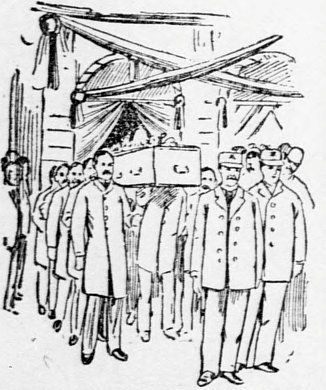
From the moment the doors of the Fire Commissioners' rooms were opened on Sunday morning until the hour arrived to bear the remains to the cemetery, a stream of people flowed past the coffin to catch a final glimpse of him who held such a prominent place in their affections. Among the arrivals a little while before the services commenced was old Melarkey Fallon, who had gone to school with the Chief long ago during their boyhood days in New York. He was eighty-three years old, and it was a great effort for him to totter from his carriage into the room where the coffin stood, even though he had the sturdy arms of two young firemen to lean upon. It had been ten years since Melarkey Fallon had crossed the bay from his Oakland home, and nothing could have brought him over but the event of yesterday. "Well, my old friend, you haven't changed much since I saw you last," murmured the old gentleman as he gazed upon the dead face; "you look just like the honest old Dave whose friendship was more to me than any treasure I have on earth." As Fallon turned away another man, bent with age, faltered to the other side of the coffin. It was Colonel J. D. Stevenson. He, too, had braved the cold and dampness to pay the last tribute to his friend. The eyes of Fallon and Stevenson met. Then the two old men who had not seen each other for fifteen years clasped each other in their arms and retired to a corner, where they lived over again the incidents of long ago in which he who was lying cold in death before them took a prominent part. After the general public had taken leave of the Chief the doors were closed to all but his intimate friends, members of the Fire Department, and the organizations of which he had been a member. There was not a great throng of them. Death had thinned their ranks. Many of those who came were snowy-haired, lame and halt and blind. First came the Veterans of the Mexican War, 60 of them, who cast tender glances at the face of their old comrade, and after them marched 150 members of the Veteran Firemen's Association, closely followed by 125 Exempt Firemen and 140 members of the Fire Department. Even the faces of the hardy young fellows who are following in the footsteps of the old fire fighters were grave and sad as they gazed on him who had so often led them to gallant victories. Men came from interior cities to pay the last tribute of respect to Chief Scannell. There were twenty-five members of the Oakland Fire Department and twenty members of the San Jose Department. From Stockton there came Sheriff Thomas Cunningham, Supervisor James Brown, Henry Esbach and Israel Rollf, all old comrades of Scannell and ex-members of the Volunteer Fire Department. Heading the San Jose delegation was ex-Chief Brown. They all took a final look at the features of their friend, and then stood with bowed heads while the priest from old St. Mary's performed the last offices of religion. "My friends," said Father Larkin, " it is not often that Catholics, Protestants, Jews and infidels meet on such an occasion as this, but the fact that you, representatives of every creed, are present here is proof more convincing than any other that could be produced that David Scannell was an upright man. People who fail to act honestly with their fellow-men are not thus honored after death. You who knew him well will bear testimony that he rendered unto all men what was theirs and held nothing back. He was the soul of honor. In the heat of excitement, while battling with that stubborn element which is the common enemy, is the condition in which we knew him best. I have witnessed every fire of any magnitude that has occurred in San Francisco during the past forty years. I have seen him rush into flaming buildings leading his men and emerge from them with singed hair, scorched flesh and shattered bones. I have seen him directing his army like a general directing the movements of his troops on a battlefield. I have seen him in moments of intense excitement, and I have seen him in times of repose. Many a time has he saluted my ears with language that in moments of coolness he would not have used, and I often wondered why it was that his men did not forget themselves and strike him down. In time I learned the reason. Those heroes knew their leader better than I did. They knew that under the gruff exterior of the lion there pulsed the heart of a child. They knew that while he was extraordinary in his behavior toward them at times, he was always the first to spring to their defense when they were assailed by others. And they were right. I grew to know him in the course of time, and I know that a kindlier nature never dwelt in the breast of man. "It is said that after fifty-three years of ceaseless activity David Scannell died a poor man. This I can readily believe after reading the accounts of his unostentatious charity. I am informed that he regularly contributed from his poor salary enough to keep several men in food, clothing, and shelter. It is an example that many a rich man might follow, a record of which any person might be proud. "Farewell, lion-hearted man. The love of a multitude of grateful people follows thee beyond the grave. May the world see many more such as thee. Christian, farewell." Out into the street filed the mournful procession, the thousands of people assembled there uncovering their heads as the casket was lifted into the hearse by twelve firemen. The pallbearers, Mayor Ellert, Supervisor Montgomery, Fire Commissioners Maurice Schmitt, Fisher Ames, Frank G. Edwards, A. J. Martin, and S. H. Brown; Exempt Firemen C. M. Plum, and George T. Bohen; Mexican War Veterans W. C. Burnett, and Samuel Deal; Fire Patrolmen John D. Comstock, and Charles Towe; Chief of Police Crowley, Captain Lees, George T. Knox, Charles H. Stoutenborough, Reuben H. Lloyd, General John McComb, Dr. Beers, and Owen Burns, ranged themselves alongside the hearse, and the procession started. 
All the streets had been cleared of cars and vehicles, so the procession had a clear line of march. In front walked a platoon of police under command of Captain Dunleavy and A Sergeants Wittman and Coles, after whom marched the Park Band playing funeral dirges. Then in the order named marched the following: Mexican Veterans, Veteran Firemen, Exempt Firemen, Members of the San Francisco Fire Department, Members of the Oakland Fire Department, Members of the San Rafael Fire Department, Members of the San Jose Fire Department. Then came the hearse, drawn by two coal-black horses, and bearing the casket, on top of which the white fire hat of the late Chief rested. After the hearse walked the Chief's horse, " Dave," wearing funeral trappings and pulling the Chief's buggy, in which sat Zip Schoen on the same side where he had often sat before while driving his old master to fires. After the buggy came a long line of carriages in which rode those of the late Chief's friends whose infirmities prevented them from walking. When the head of the procession turned into Post Street the end was just moving from the Old City Hall. The crowds on the sidewalks did what San Francisco crowds are not accustomed to doing—the men raised their hats as the hearse passed them. It was a voluntary tribute of respect that demonstrated the strength of the hold Scannell had on the affections of the people. Slowly the cortege passed along Kearny Street, and out Post Street to Van Ness Avenue, where the walkers dispersed, many of them, however, entering carriages and proceeding ""to the cemetery. 
At the cemetery a mighty throng awaited the arrival of the cortege. The vicinity of the firemen's plot was so densely packed that hundreds of people were crowded on to the plot itself and up to the very brink of the open grave. The services of a dozen policemen were required to clear the space around the grave so that the procession might not be retarded upon its arrival. In a few minutes the seven wagons carrying the floral tributes arrived. So numerous were these that the entire plat, back to the rear of the grave, was covered over with them. Among the largest and most beautiful stands were a fire patrol wagon from the Underwriters, a bell with the inscription "His Last Call; Box 41," from the alarm office, a cross inscribed, " His Last Call," with a wreath and doves, from the Commercial Fire Dispatch, a broken wheel from Truck , No. 3, a wheel from the Fire Committee of the Supervisors, a pillow inscribed " My friend," from Dr. B. Beers, a fireman's badge, axes, and hat from the Mayor and Supervisors, a scythe and sheaves of wheat from Chemical Engine No. 1, a speaking trumpet from Engine No. 8, a chair and fireman's hat from the Fire Commissioners, a tugboat from the men of the fireboat " Governor Markham," a hydrant from the Spring Valley Water Company, a stand of lilies from Mrs. Charles Towe, a stand inscribed, "He Died as He Lived, Our Chief," from Mr. and Mrs. Samuel Rainey, a "gates ajar" inscribed "Rest, Chief," from Engine No. 3, a cross and wreath from Chemical Engine No. 6, a heart and scythe from Patrick Curran, a "gates ajar " and s fire bell from Engine No. 7, a " gates ajar " and fireman's hat from Engine No. 15 and Chemical Engine No. 4, a pillow inscribed "His Last Call," with trumpet and doves, from the Sacramento Fire Department, a pillow, badge and crossed trumpets from Hose No. 1, a column of ivy and badge from Engine No. 10, a cross and scythe from Hose No. 5, a ladder from the California Hotel, a scythe and wheel from Truck No. 5, a clock with hands pointing at nine o'clock (the hour of the Chief's death) from Hose No. 8, a broken wheel from the Corporation Yard, an ivy pillow and badge from the underwriter's, a fireman's hat from Joseph Marshall, a badge from Engine No. 13, a pillow inscribed "The Hero—1820-1893" from Hose No. 2, pillow from Engine No. 12, a ladder and "gates ajar,'' from Engine No. 1, axes, trumpet and fireman's hat from Engine No. 18, an ivy cross from Hose No. 14, an ivy cross from Engine No. 14, a firehouse with flag half-masted from Chemical Engine No. 5, an urn from the officers of the department, a chair from Engine No. 9, axes from Truck No. 2, "gates ajar" from Engine No. 16, lilies and a cross from Miss E. F. Bohen, a candelabra from the Superintendent of Streets' office, a clock with hands pointing to nine o'clock from the department carpenter shop, a cross from chemical Engine No. 3, a pillow and trumpet from W. T. Y. Scherick, a pillow from Mrs. J. W. Murphy. Reverently they carried the casket from the hearse and lowered it into the grave, close by the resting places of Captain Riley, Chief Kohler, and that hero who was killed by an explosion of gas in the Grand Hotel two years ago. Forming a circle around the grave were the organizations, and back of them stood the friends of the late Chief, while drawn up a few yards distant from the head of the grave was the firing party of cavalry under the command of Lieutenant Davis, whom General Ruger sent over from the Presidio. Forming the background was the crowd of people, the green hills, and a bit of the ocean. Because of the dampness of the atmosphere the men did not remove their hats. The male choir of the First Congregational Church, led by Samuel D. Mayer, was present and rendered the hymn, " Shall We Meet beyond the River ? " Then, "Good Night, I Am Going Home '' was sung, three volleys were fired, taps were sounded on the drum, and "lights out " by the bugler, the grave was filled with earth, and all that was mortal of David Scannell was left in solitude. RELATED ARTICLES SPLENDID GIFT TO CHIEF OF FIRE DEPARTMENT 1863 September 9 — David Scannell, Chief Engineer of the Fire Department of the city of San Francisco, was the recipient, yesterday, of a magnificent cane, gold-mounted, the gift of the San Francisco Board of Underwriters and Insurance Agents of San Francisco. The subjoined is the inscription: " David " Scannell, Chief Engineer of the San Francisco Fire Department: From tbe members "of the Board of Fire Underwriters, September, 1863." Herewith we give the letter of the donors which accompanies the gift: To David Scannell, Chief Engineer of the San Francisco Fire Department: The undersigned, members of the San Francisco Board of Underwriters, take this method of tendering to you their regard, for the faithful and efficient manner in which you have discharged the duties of Chief Engineer of the Fire Department. In bearing this testimony to your character and conduct, they believe they express the opinion of the entire public. Without intending to be invidious, they take pleasure in saying that at no time since the organization of the Department of which you are the head, has it been more efficient. PRESENTATION City Items The Annual Reports of Chief Engineer David Scannell as published in the Municipal Reports, City & County of San Francisco 1863 Report of the Chief Engineer 1885 FDNY - Reminiscences of The Old Fire Laddies |
||||||||


